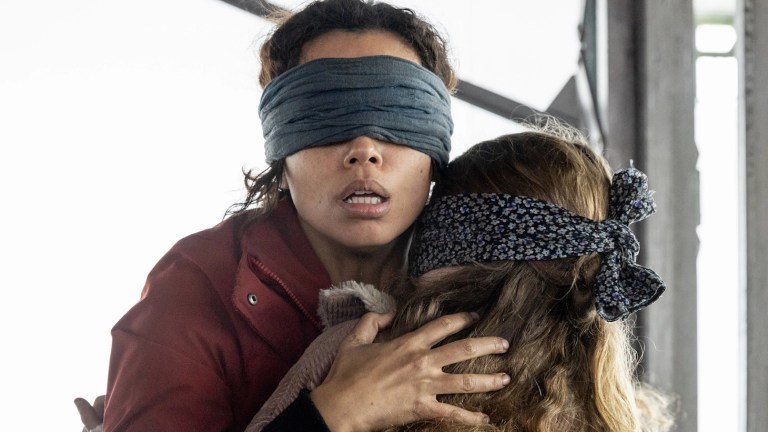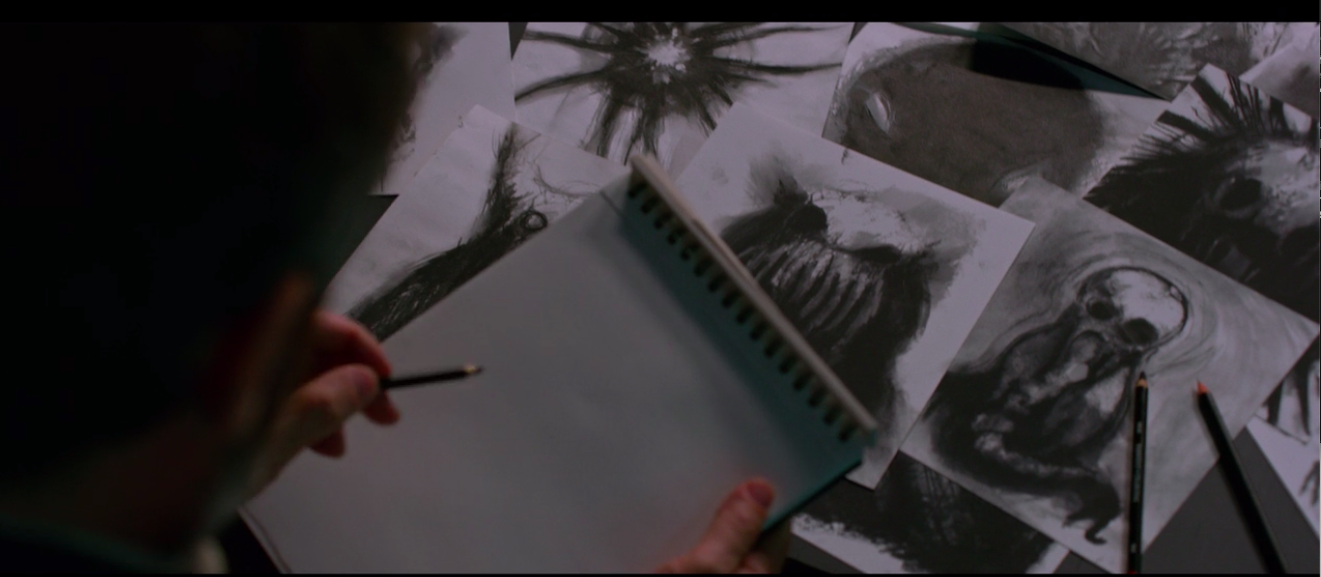Bird Box Creatures Explained
Just because the Bird Box creatures aren't technically visible doesn't mean we can't figure out what they're all about. And Bird Box: Barcelona has just given us enough creepy clues to revisit the whole concept.

The following contains major spoilers for both Bird Box: Barcelona and Bird Box.
Much to some viewers delight (and others’ annoyance), Netflix’s buzzy horror saga, which has grown out of a 2018 zeitgeist-y hit into a bonafide franchise via this weekend’s Bird Box: Barcelona, continues to take its cues from The Blair Witch Project. That is to say, they never show us the damn monster! Or in Bird Box’s case, monsters or creatures, plural.
This is of course thematically sound. The characters of both Bird Box (directed by Susanne Bier) and Bird Box: Barcelona (from writer-directors David Pastor and Alex Pastor) cannot gaze upon the creatures terrorizing them without being driven to suicide. So why would the movie show us? Netflix can’t have 45 million dead viewers on its hands after all!
But just because we never see the creatures, doesn’t mean we don’t learn anything about them. Based on context clues and some of our other non-sight senses, we are able to determine certain properties about these unnamed creatures and perhaps get a solid understanding of them. So without further ado, here is everything we know about those terrifying invisible thingies.
First, let’s examine what the first Bird Box tells us about the creatures. For starters, we do know that it’s “creatures” and not “creature.” Characters routinely reference the entity threatening humanity as “them.” Many critics have pointed out the film’s similarity to M. Night Shyamalan’s The Happening. In The Happening, Mother Nature herself decided she had quite enough of humanity’s shit and begins releasing toxins into the air that cause people to kill themselves.
In Bird Box, however, the inspirer of suicide isn’t nature but rather these mystical, invisible assailants. How do these creatures cause human beings to commit suicide though? The short answer is “magic,” essentially. The slightly longer answer is magic combined with visual and auditory hallucinations oftentimes specific to the viewer of the creatures.
Being haunted and seduced by the dead is a frequent symptom for those who see the creatures. Near the end of the first film, Malorie (Sandra Bullock) is assaulted by the disembodied voices of the dead, including Tom (Trevante Rhodes) and Douglas (John Malkovich). During the initial North American panic, Douglas’s wife walks to her death in a burning car, and mentions seeing her mother who has been dead for ten years.
While personalized delusions are certainly a common feature following exposure to the creatures, it’s not the only one. Occasionally people who see them react with simple panic, fear, followed by the telltale uncontrollable urge to commit suicide. When Malorie’s sister Jessica sees the creatures in the beginning of the film, her eyes glass over, she begins to tremble and cry and she mutters “what the fuck is that?” It’s possible that Jessica is witnessing she and Malorie’s dead father, but she does not address him directly.
Bird Box: Barcelona slightly deepens and expands this idea (although not by as much as some viewers likely hoped). In the sequel, we witness there is actually a range of responses to seeing the creatures. Some act as despondent or comatose as the characters in the first film. Others though act enchanted or enamored with either the creatures or whatever they represent in the victim’s head. One woman talks to someone she refers to as her “love” as she climbs face first into a rapidly rotating tire.
We also see how one victim who becomes a “seer” (more on them below) interprets the creatures’ influence. He imagines his dead daughter, who was driven to suicide by being forced to look at the creatures, and she in turn urges him to act as a shepherd. She wants him to force other people to look on these “angels,” thereby saving their souls from this mortal coil. The revelation suggests the creatures not only induce hallucinations, but actually are somehow creating a psychic rapport with the victim and very intentionally manipulating them to self-harm while they’re in a kind of trance.
This honestly raises the question of to what end would a “creature” do this? Are they as mystical as the second film suggests? While we are obviously not meant to mistake them for angels like that movie’s poor Sebastián, but they certainly seem metaphysical in the way that Sebastián’s alleged daughter can appear to him and drive him toward luring other people to the creatures—even when there is no creature anywhere near Sebastián when he is having these visions. Additionally, if they were just aliens or animals, what kind of sustenance or power could they get from people hurting themselves?
Of course, as first Bird Box later revealed not everyone is fatally “allergic” to the creatures. Some select individuals are not driven to suicide after seeing them. Instead these select few become obsessed and captivated with the creatures, going so far as to urge the rest of the population to take off their blindfolds so they can witness the creatures’ beauty. In that film, a character named Gary (Tom Hollander) gives us some more clues about the kind of people who have this reaction to the creatures. According to Gary, “crazy” people or people who were institutionalized for one reason or another aren’t driven to suicide by the creatures. Gary doesn’t specify what “crazy” means. It’s unclear whether these individuals suffered from an illness like schizophrenia, or have no chemical imbalances in their brains at all but were rather “touched” by these creatures in some way prior to their arrival. Whoever or whatever these people are, it soon becomes clear that Gary is actually one of them.
It’s worth noting that Bird Box: Barcelona contradicts (or at least expands) on this idea. In the sequel, Sebastián was never “crazy.” He was a doting father who wanted to protect his child. However, there does seem to be something in specific personalities that help turn some folks into veritable “Renfields” for the creature. The priest who ultimately brings Sebastián before the creatures is also not “crazy,” but he has an air of zealotry about him before seeing the creatures. He wants to believe in “an age of miracles,” so the creatures appear to feed on that nature in him.
More curiously at the end of the movie, a doctor hypothesizes some folks are genetically predisposed to become enthralled by the Creature, and in this way they might be cured. Personally, we think this is unsatisfying sequel-bait and world building. In fact, the first film suggested something much more abstract, yet satisfyingly unsettling.
If you recall during the first film, Tom Hollander’s zealot (or “seer”) has an opportunity to reveal and lovingly caress drawings he’s sketched of the dark monsters. This, in fact, is the only visual representation the movie offers up of the creatures. Fittingly, no two drawings are the same. It is clear that these creatures are all different in appearance or shape shift to some degree. Still, the appearance of the creatures in Gary’s drawings all do have a consistent styling that offers an important clue as to what the creatures really are.
To be clear, there is no right answer as to “what are the Bird Box creatures?” But the drawings that Gary provides along with other clues makes it pretty clear what they were inspired by. The creatures of Bird Box are heavily influenced by the works of H.P. Lovecraft. Lovecraft is one of the American fathers of sci-fi/horror fiction. Lovecraft developed a dark style, focused on abominable monsters, that would come to be known as “Lovecraftian.”
Many of the creatures that Gary has drawn resemble the monsters of Lovecraftian lore. But none more so than the most prominent drawing that Gary has displayed front and center. That weird little dude has tentacles on his face! And it just so happens that a tentacle face is one of the most frequently depicted features on Lovecraft’s best known monster, Cthulhu.

Again, the creatures of Bird Box aren’t necessarily literal Cthulhu and the rest of his terrifying “Great Old One” companions. The tentacles however are a dead giveaway that they’re at least in part inspired by them. And if their appearance wasn’t enough, the Bird Box creatures share one very important feature with the Great Old Ones. Upon viewing Cthulhu, people are driven stark raving mad. The creature is so enormous, so unholy, so powerful, that the human mind cannot comprehend it. In fact, the opening line of Lovecraft’s short story, “The Call of Cthulhu” is “”The most merciful thing in the world, I think, is the inability of the human mind to correlate all its contents.”
So what happens when the mind is confronted with the truth… the real, unvarnished truths of the universe in creature form? Well, I imagine most people would kill themselves. And perhaps some would see the beauty in it.
Bird Box and Barcelona both refuse to give its viewers any solid answers as to what the creatures that terrorize its characters really are. For all we know, the creatures really could be a manifestation of nature, tampering with everyone’s brain chemistry a la The Happening. What’s likelier though is that the creatures driving humanity mad are really Lovecraftian abominations.
Now as to why birds are sensitive to the creatures? Probably because birds rule.
